- Training & Sims
- Charts & Plates
- Free Enewsletter
- Digital Issues
- Customer Service
- Reset Password
- Give a Gift
- Pay My Bill
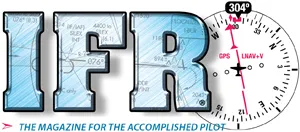

Mastering Cruise Descents
Proper energy management during descents means you go faster, keep your engine happier and maybe save some cash. what could be better heres the low-down on the go-down..
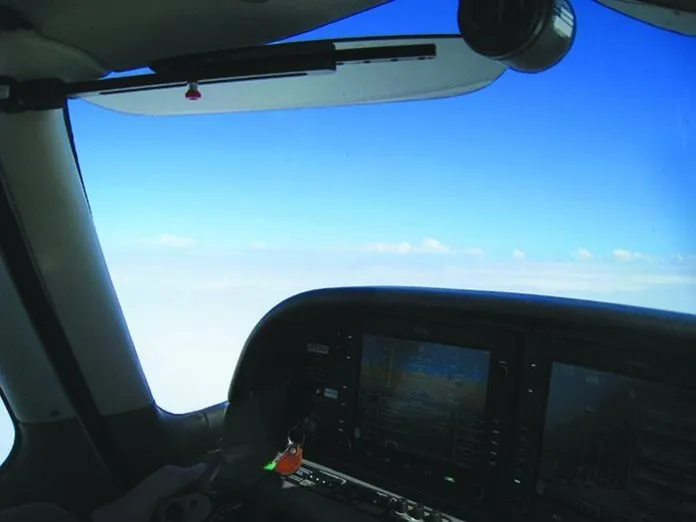
Let’s fire up the Wayback machine and set it for high school physics class. As an aircraft climbs, it burns fuel (and by extension, money) to provide kinetic energy. That energy is used for climb performance and airspeed (countering that demon drag in the process). Once the aircraft is tucked away at a cruise altitude, some of that formerly-kinetic energy is available as potential energy due to the force of gravity acting on the aircraft. Potential energy can be converted back into kinetic energy by initiating a descent, which you can observe as increasing airspeed (all else remaining equal).
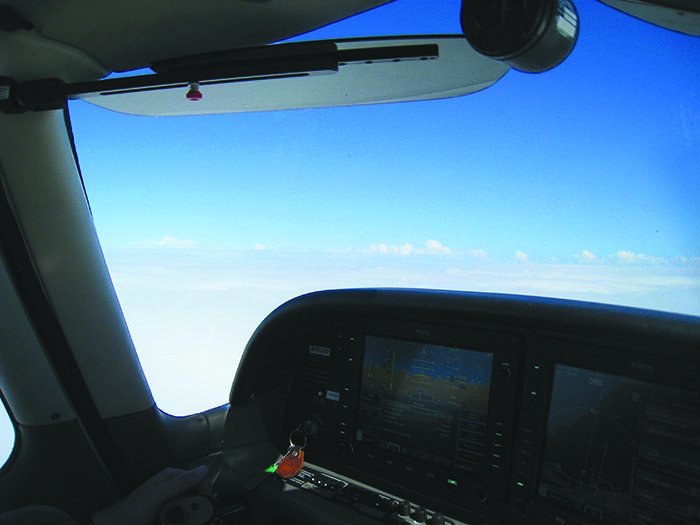
OK, that’s over simplified. But the fact remains that there is an opportunity latent in the energy stored by being up high. Here’s some similarly simplified logic: Airplanes speed up during descents; pilots usually like going fast; a faster airplane gets to its destination quicker, which usually saves money; pilots like saving money. Therefore, pilots should descend fast.
Except that many don’t.
Relearning the Basics
“What’s learned first is learned best” is a wonderful tool if used properly by instructors. However, the majority of pilots that I’ve flown with over the years exhibit the same behavior when it comes to descents. These pilots initiate a descent by first reducing power, then pitching down to maintain their cruise speed, further reducing power to keep that speed while descending at a reasonable rate. Sound familiar?
When flying a low-performance aircraft like a Skyhawk or a Cherokee, at relatively low cruise altitudes, it really doesn’t make much difference whether you fly a cruise-power descent or a reduced-power descent—you might hit 120 at cruise power as opposed to 105 at reduced-power. It’s when these same pilots upgrade to higher-performance aircraft with cleaner airframes and higher cruise altitudes, such as a Centurion or Bonanza, and don’t alter their style of flying that it becomes an issue.
The basic premise is that after spending a significant investment of time and fuel (money) climbing up to cruise altitude, you want to plan and execute your descent on the other end of the flight in order to make optimum use of your stored potential energy. You also don’t want to give up too early the higher true airspeed at altitude due to the thinner air or spend longer than necessary down low when clouds or wind make it a bumpy mess near the ground. Don’t worry, it’s not as scary as it sounds and there won’t be a test at the end, just smaller bills to pay.
Managing the Descent
Planning a descent is not rocket science, it’s just some simple mental math. I prefer to plan for 500 FPM descents because it makes the math easy and it’s easy on unpresurized ears. For instance, if you’re 8000 feet above your target altitude, it will take you 16 minutes to get there at 500 FPM, regardless of your airspeed. What trips up many pilots is determining how far from the target the descent should begin.
I like simple numbers for mental math because they build in wiggle room. Will your descent be roughly 120 knots, such as in a Skyhawk? Plan on two miles per minute over the ground, which means you start down 32 miles before your target (16 min x 2 nm/min). Going a bit faster, such as in a Centurion? Ballpark it at 180 knots and plan on three miles per minute. The same 16 minutes requires starting down 48 miles out. Now pad each of them by a couple miles and you should be good to go. Most modern GPS units have VNAV planning built in, but it usually takes just as long as the mental math to set up.
Staying below the yellow arc on the airspeed indicator makes one less thing to think about when you hit some bumps punching through a cloud layer. During a descent rate in the 500-FPM neighborhood, this is usually not a factor because in a cruise descent like this, I’ve found most clean retracts will pick up about 25-30 knots. You would have to shove the nose over real far to have airspeed limitations become a problem, and by that point any passengers in an unpressurized cabin would probably be strangling you anyway.
I’m in the camp that says cruise power descents also avoid shock cooling the engine(s) and that you make gradual power reductions of one inch of manifold pressure per minute to keep big-bore engines happy. Just look at the difference between your current power setting and the desired power setting at your target and then apply the same 2 nm/min or 3 nm/min rule discussed above. Reduce power not only enough to keep the MP from increasing as you go down (if you’re not turbocharged) but enough to actually decrease the MP every minute. Remember that once you nose down and pick up some speed, it takes a little while for the speed to bleed off when power is reduced and the descent maintained.
Playing the ATC Game
No discussion of descents could be complete without bringing up ATC. ATC demands can be the limiting factor when it comes to your descents, regardless of what you had in mind, but only if you let them. Correlating your needs with ATC’s needs usually isn’t that difficult.
For starters, asking for a descent at pilot’s discretion (PD) might be all that’s needed. During a PD descent, ATC gives you the freedom to descend at any rate you choose, and to begin descent whenever you choose. Contrast that with the standard “descend and maintain” verbiage, which expects you to descend “at an optimum rate consistent with the operating characteristics of the aircraft,” but it’s not to be lower than 500 FPM.
Second-best to the PD descent is a crossing restriction, which is stated as “Cross ALDAN at and maintain 7000.” This restriction still gives you a little freedom by allowing you to descend however you choose, so long as you are at 7000 by the time you pass ALDAN. You may need to redo your mental calculations to make it work. Sometimes the controller has his hands full in a busy terminal area and can’t give you much wiggle room. That’s just the nature of the game.
Mileage May Vary (Literally)
There’s nothing inherently wrong about a low-power, gradual, cruise descent. But there’s nothing inherently wrong about flying down final at 90 knots into Big City International, either. However, in both cases there exists a better way so long as you put enough thought into it so you don’t get caught at the end with too much speed or altitude.
Cruise descents result in an incremental gain. Saving 5 to 10 minutes per flight might seem insignificant and could easily be wiped out by a bad vector in the terminal area. However, shaving off that kind of time on average over the course of just a handful of flights, could easily save a half hour or more. The engine health benefits resulting from this change are indeterminate, but there’s a reason the companies that sell spoilers for high-performance airplanes are still in business and why Part 135 operators that practice good energy management get extended TBOs on their motors.
Both those factors translate directly to your wallet, and that surely makes every pilot happier.
RELATED ARTICLES MORE FROM AUTHOR
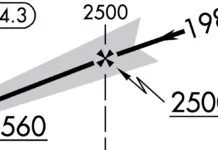
Make a Safety Net
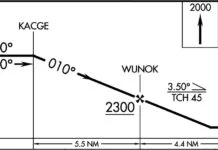
Can You Handle It?
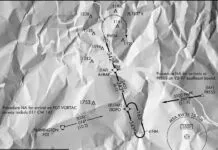
Plans Change
Leave a reply cancel reply.
Save my name, email, and website in this browser for the next time I comment.
- Online Account Activation
- Privacy Policy
- Terms of Use

Briefing: August 2017

Cruise and Descent: Aerodynamics of Manoeuvres
When it comes to aircraft flight, two primary phases often garner immense attention from an aerodynamics perspective: cruising and descending. These phases are fundamental not just from an operational perspective, but also from an efficiency and safety viewpoint. The aerodynamics involved in these manoeuvres are multifaceted, determined by a combination of aircraft design, aerodynamic principles, and atmospheric conditions. This detailed exploration delves into the intricate aerodynamics of cruising and descent manoeuvres.

Table of Contents
1. Basic Aerodynamics:
Before we delve into the specific phases of flight, let’s understand the fundamental aerodynamic forces that act on an aircraft:
- Lift: The force that enables an aircraft to rise off the ground, counteracting its weight.
- Weight (or Gravity): The downward force due to the mass of the aircraft and the gravitational pull of the Earth.
- Thrust: The forward force produced by the engines, allowing the aircraft to move forward.
- Drag: The resistance encountered by the aircraft as it moves through the air.
The balance or imbalance between these forces defines an aircraft’s motion. During cruise and descent, these forces play pivotal roles in determining speed, altitude, and direction.
2. Aerodynamics of Cruising:
Cruising is the phase where an aircraft maintains stable flight at a designated altitude. For commercial airlines, this is typically at high altitudes, usually above 30,000 feet.
2.1. Maintaining Equilibrium:
During cruise, lift essentially equals weight, and thrust balances drag. This equilibrium ensures the aircraft maintains a constant altitude and speed.
2.2. Factors Influencing Cruise Efficiency:
- Aircraft Design: Modern aircraft, especially commercial airliners, are designed with cruise efficiency in mind. Features such as winglets reduce induced drag and improve fuel efficiency.
- Altitude: At higher altitudes, the air is less dense. While this means reduced lift, it also translates to lower drag. Therefore, aircraft engines can work more efficiently, consuming less fuel.
- Airspeed: Every aircraft has an optimal cruising speed, which provides the best fuel efficiency. This speed maximizes the lift-to-drag ratio, often referred to as the L/D max.
- Engine Efficiency: Turbofan engines, commonly used in commercial airliners, are optimized for high-altitude cruising. Their design prioritizes fuel efficiency during this phase.
3. Aerodynamics of Descent:
Descent is the phase where an aircraft reduces its altitude in preparation for landing. The primary goal during descent is to decrease altitude while maintaining control and ensuring passenger comfort.
3.1. Glide Descent:
In a glide descent, power is reduced, and the aircraft descends primarily due to its weight. The descent rate and forward speed are controlled by adjusting the aircraft’s attitude and configuration.
- Lift-to-Drag Ratio: This ratio is crucial during a glide. An aircraft with a high L/D ratio can glide further for a given altitude loss than one with a lower ratio.
- Control Surfaces: Adjustments to the ailerons, elevators, and rudders help control the descent rate, direction, and attitude.
3.2. Powered Descent:
In some situations, pilots might opt for a powered descent, where engines are not idle, and there’s a deliberate use of thrust. This approach offers more control but is less fuel-efficient.
- Air Brakes/Spoilers: These devices disrupt the airflow over wings, reducing lift and increasing drag. They help in controlling the descent rate and speed.
- Thrust Reversers: Some aircraft are equipped with mechanisms that can redirect the thrust produced by engines. While mainly used during landing to decelerate, they can also aid in descent.
- Flaps and Slats: Extending these increases the wing’s surface area and curvature, enhancing lift at lower speeds. They allow aircraft to descend at steeper angles without gaining excessive speed.
4. Challenges and Considerations:
4.1. turbulence:.
Turbulence, both in cruise and descent, is caused by various factors like thermal currents, jet streams, or weather fronts. Aerodynamically, turbulence can cause fluctuations in lift, which might result in an uneven flight experience. Aircraft are designed to withstand such variations, and pilots receive training to manage and mitigate the effects of turbulence.
4.2. Fuel Efficiency:
For commercial operators, fuel efficiency is paramount. Efficient cruising and descent not only save costs but also reduce the carbon footprint. Therefore, understanding and leveraging aerodynamic principles are critical.
4.3. Air Traffic:
In busy airspaces, aircraft may need to adjust their cruising altitude or descent profile to avoid traffic. Such adjustments require a deep understanding of aerodynamics to ensure safety and efficiency.
4.4. Atmospheric Conditions:
Factors such as temperature, pressure, and wind play crucial roles. For instance, descending with a strong tailwind might necessitate additional drag (using spoilers or air brakes) to maintain desired speeds.
5. Technological Advancements:
5.1. fly-by-wire:.
Modern aircraft leverage computer systems that assist pilots in controlling the plane. These systems optimize aerodynamic performance by automatically adjusting control surfaces, ensuring efficient cruise and descent.
5.2. Real-time Data Analysis:
With the advent of advanced sensors and data analytics, pilots can receive real-time feedback on aerodynamic performance, allowing them to make informed decisions.
5.3. Advanced Propulsion:
Emerging propulsion technologies promise enhanced efficiency. Electric and hybrid propulsion systems, for example, might redefine how we understand thrust and power management during cruise and descent.
Conclusion:
The aerodynamics of cruising and descent are both intricate and fascinating. As aircraft journey through the skies, they navigate a complex interplay of forces, atmospheric conditions, and technological interventions. While the principles of lift, weight, thrust, and drag remain foundational, the nuances of their applications during cruise and descent phases present ongoing challenges and opportunities for innovation. Whether it’s designing more efficient wings, leveraging advanced propulsion systems, or incorporating real-time aerodynamic data analytics, the quest for safer, more efficient flight continues to drive the aerospace industry forward.
- GOLN Principles of Flight Book: Table of Contents
Leave a Comment Cancel reply
Save my name, email, and website in this browser for the next time I comment.

How Fast Do Airplanes Fly? Climb, Cruise & Descent
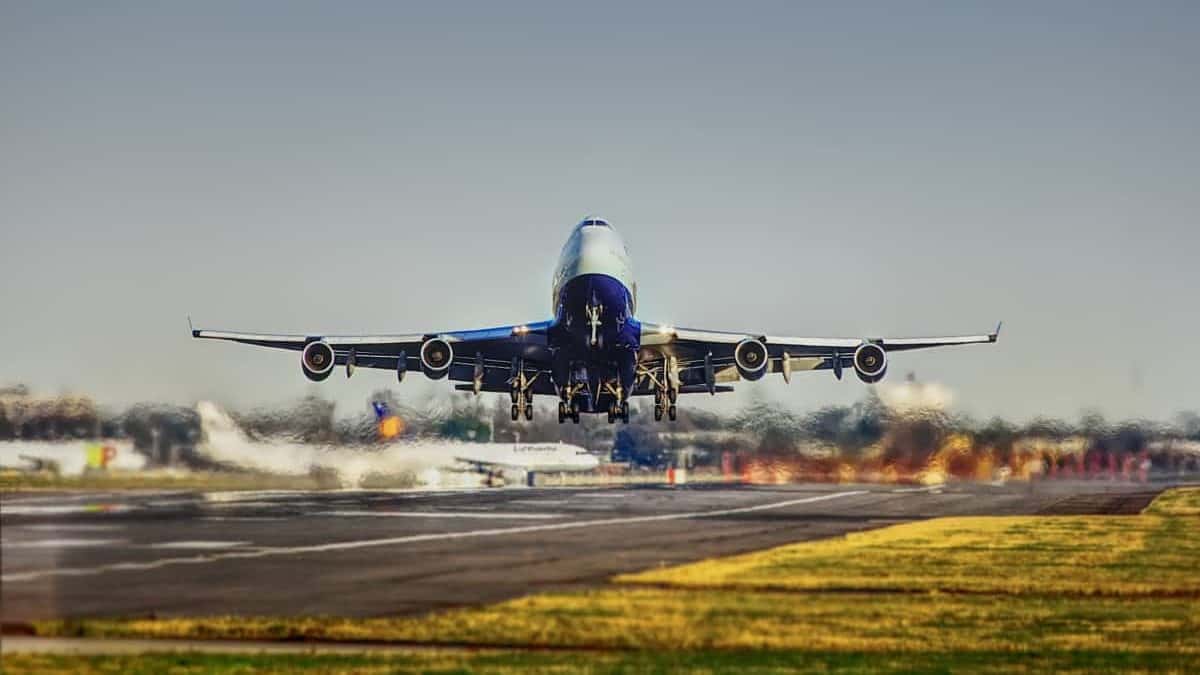
Flying for any amount of time can soon get boring so the faster it takes the better. Have you ever wondered if pilots fly planes at their maximum speed or are they limited like we are driving a car down the highway? We all know airplanes are fast, the question is though, just how fast?
At takeoff, most passenger jets are traveling around 150-180knots/170-210mph. They will then climb at a maximum speed of 250kts/290mph while under 10,000 feet and then can speed up to 280-300kts/320-345mph for the rest of the climb. Cruise speeds of most passenger jets are around 600kts/700mph.
To find out all about the different speeds an airplane flies at please read on…
Large Commercial Aircraft Speeds:
What is an airplane’s speed at takeoff .
Most commercial airliners use three different speeds for takeoff. These are: V1 , VRotate and V2 . For the Boeing 737-8 or the Airbus A320 family, these speeds are in the region of between 125knots (143mph) to 175knots (200mph).
The V1 or Decision Speed is the speed pilots calculate to know what is the maximum speed they can reject the takeoff. This speed depends on the weight of the aircraft, humidity, outside air temperature, weather, condition of the runway, length of the runway etc.
V1 speed is usually around 140knots +/- 5 knots (Around 160mph)
The Vr or VRotate Speed is the calculated speed at which the pilot flying (One pilot manipulates the controls while the other monitors the instrumentation) pulls back on the yoke or stick to lift the aircraft off the ground. Vr Speed is always equal to or higher than V1, but it can not be lower.
Vr Speed is usually also around 140knots +/- 5 knots (Around 160mph)
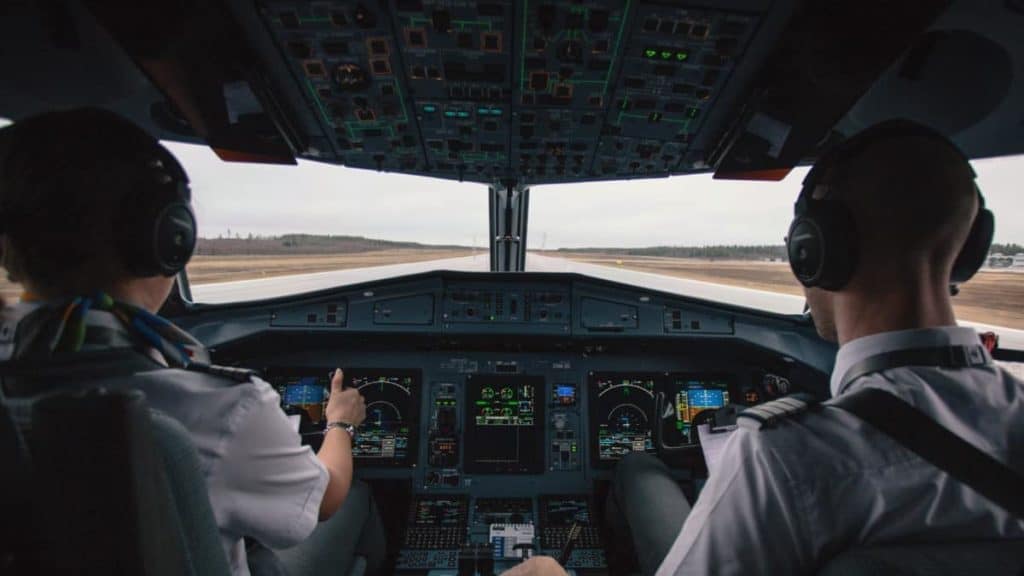
V2 Speed:
The V2 Speed is the speed of the aircraft at 50 feet above the ground. This is the speed the aircraft uses to climb to at least 400 feet above the runway and it’s always 5 knots greater than the Vr speed. In case of an engine failure on takeoff the V2 speed will keep the aircraft safe and on a shallow climb while still avoiding obstacles.
V2 speed is usually also around 145knots +5/-0 knots (Around 166mph)
What is an Airplane’s Speed During the Climb?
The speed of an airplane during its climb varies greatly with the wind and the weight of the aircraft, but all aircraft must abide by maximum airspeed limitations set forth by the world’s aviation governing bodies.
From liftoff up to 10,000 feet above Mean Sea Level (MSL), all pilots must NOT fly their airplane faster than 250knots or 288mph, unless they request to do so with air traffic control. This speed limit is to help air traffic controllers control the flow of aircraft into and out of airports below.
This slower speed also allows for more power to climb faster allowing the airplane to quickly climb through the busy airspace surrounding each airport. Above 10,000 feet the pilots are allowed to speed up so their speed usually increases to 280-300knots, but in doing so their rate of climb will reduce.
Once passing around 24,000 feet MSL pilots will then speed up again to around 350-430knots (400-500mph). This slows the rate of climb again but improves the time taken to complete the flight. This configuration allows for a steady climb up to cruising altitude while flying at a fast enough speed to ensure the passengers get to their destination in a reasonable time.
The faster an airplane flies, the slower it climbs. Engines can only supply a set amount of power so pilots have to select which flight regime they take.
Think of it like towing a trailer with a truck. On the flat road section, you can flatten the accelerator and your truck max’s out at 100mph. You then come to a hill and still with your foot to the floor your truck can now only climb at 80mph while towing. This is the same with the airplane.
Learn More … Try These Articles: * How Much Do Airplanes Weigh? (With 20 Examples) * This Is Why Pilots Reduce Thrust After Takeoff?
What is an Airplanes Cruise Speed?
The speed of a typical airliner in cruise is usually up to 600kts/700mph/960kph. In the cruise, the pilots use the airplane’s Mach Number for controlling its speed as this number is not affected by atmospheric pressure at cruise altitudes.
What is the Mach Number?
It’s basically the speed of the aircraft expressed as a percentage of the speed of sound (666 knots/766mph/1233kph). Controlling an aircraft by the Indicated Airspeed(IAS) at high altitudes is not efficient because the IAS is decreasing with increasing altitude and is also dangerous for speed control since the aircraft might find itself in an overspeed or underspeed condition.
As you can see in this picture, in the left top corner of the right-hand screen, .77 is the selected Mach Number which results in a 244knots IAS.
The Ground Speed on the other hand, as seen on left-hand screen, top left corner is well over 410knots or 500mph/900kph.
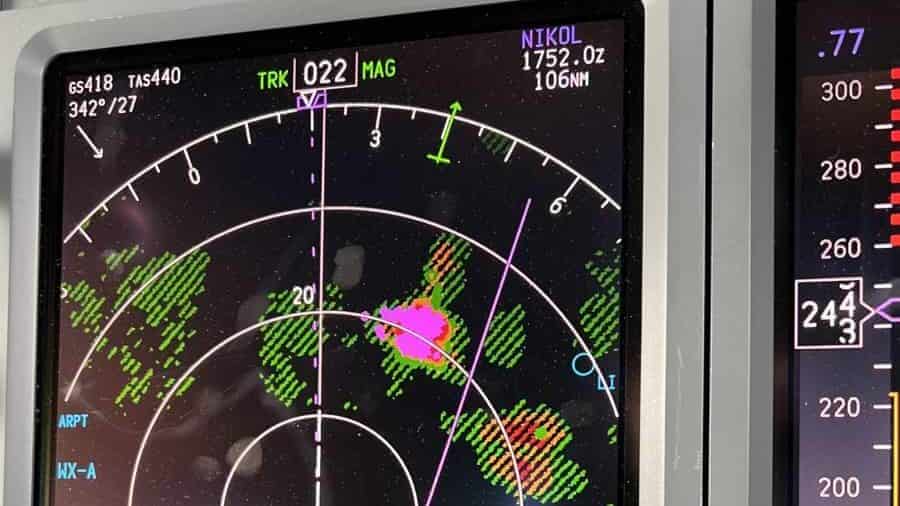
Think of speeds like this:
- Ground Speed is the speed the airplane’s shadow is moving over the ground
- Indicated airspeed is the speed of the airflow hitting the nose of the aircraft
The arrow in the top left corner is showing the wind outside. In relation to the aircraft, the wind is blowing from the pilots’ 10 o’clock position at about 27knots. This makes the airplane fly slower because it is a headwind.
If the wind was blowing from behind the aircraft this is known as a tailwind and will give the airplane a push resulting in a faster speed over the ground for the same indicated airspeed.
Usual cruise speeds are in the region between 400kts/450mph to 560kts/650mph and it is greatly affected by the wind.
The stronger the tailwind, the faster the airplane moves over the ground, the stronger the headwind the slower the airplane moves over the ground for the same indicated airspeed.

Join My Newsletter & Get Great Tips, Information and Experiences To Help You Become a Superb Pilot!
- Wanting To Become A Pilot
- Student Pilot
- Aready A Pilot
- Aviation Enthusiast
- Money Saving Course
What is an Airplane’s Speed During Descent?
The speed on the descent is somewhat like the climb speed. Initially, the aircraft descends from its cruising altitude by the pilots changing its Mach number. The slower the speed, the less lift the wings produce and gravity does the rest.
Once the airplane passes through 29,000 feet the pilots start using the Indicated Airspeed again.
Ground Speeds during the descent usually vary between 345kts/400mph to 435kts/500mph depending on if the airplane has a headwind or a tailwind.
Passing through 10,000 feet MSL, the same Air Traffic Control restrictions apply as the climb, so the pilots have to slow down to a maximum of 250knots (300mph). Ground speeds again vary between 300mph to 400mph depending on the wind.
What is an Airplane’s Speed at Landing?
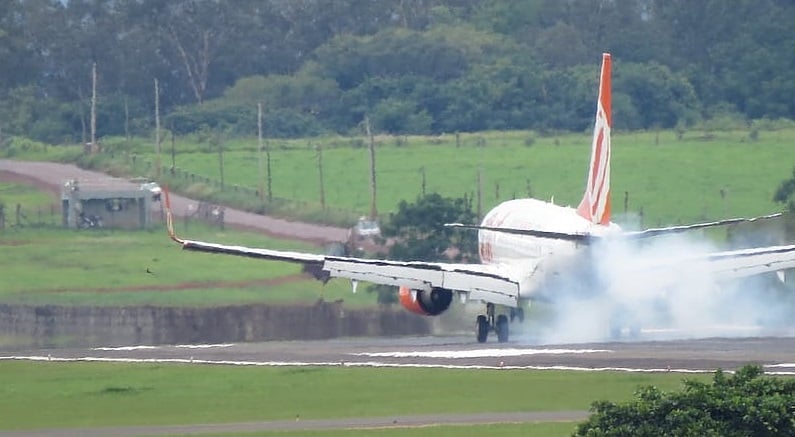
The landing speed of a commercial airliner is greatly affected by the actual weight of the aircraft. The higher the weight, the higher the speed needed. More lift is required for the heavier load. To get more lift the airplane needs to be flying faster.
The typical speed region at landing for a large airliner is usually 120kts/140mph to 155kts/180mph.
What is an Airplane’s Speed During Taxiing?
Since we are talking about speeds in flight it would be appropriate to at least mention the speed of aircraft on the ground. Aircraft inside the apron usually taxi with 10 mph maximum. Outside of the apron, this speed is increased to a maximum 30 mph.
The apron is the area immediately surrounding the terminal gates and where ground personnel are scurrying back and forth servicing the waiting aircraft. Once the airplane gets out onto the less busy taxiways the pilots can then speed up.
Light Aircraft Speeds:
Although the skies are dominated by the ‘Heavy Iron’, there is a tonne of light aircraft flying around and they too have certain speeds the pilots have to maintain to ensure a safe flight.
Light aircraft like the Cessna 172 or the Diamond DA40 only use one speed – The Indicated airspeed. They do not have the need for V1, Vr, or V2 like large commercial aircraft do, simply because they only have one engine, plus they are not going that fast.
What is a Light Airplane’s Speed at Takeoff?
The takeoff speed for light aircraft can be as low as 45mph. One of the biggest things affecting the takeoff speed of a light aircraft is the size of the wings (wing span) and the engine power. Both can significantly decrease the takeoff speed.
Large wings produce lots of lift meaning the aircraft needs less airflow over them to get airborne. Powerful engines mean they can accelerate the plane to lift off speed in a much shorter distance.
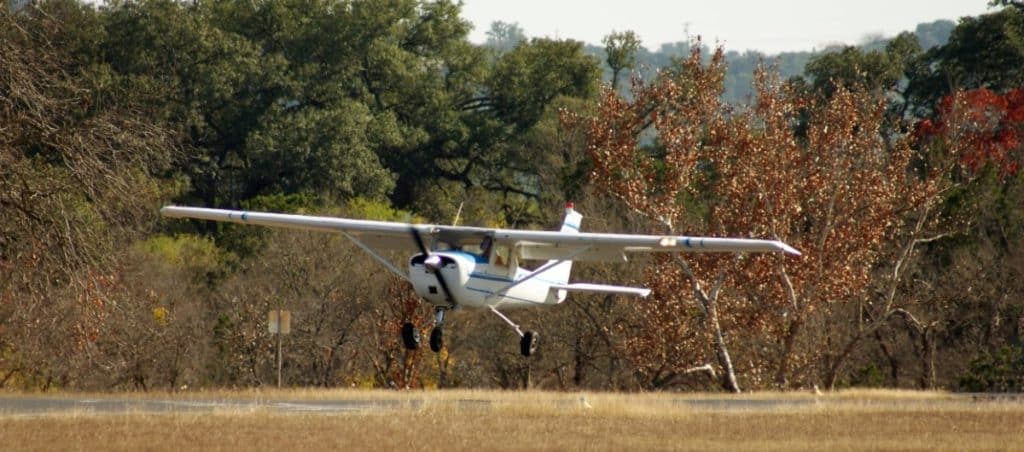
Typically most small aircraft lift off around 60mph. This gives a good buffer between the power it can produce and its stall speed.
The stall speed is the airspeed at which there is not enough air flowing over the wings to lift the aircraft into the air. An aircraft stalling close to the ground usually ends in a wreckage of the aircraft.
What is a Light Airplane’s Speed During Cruise?
Cruise speeds for most light aircraft vary between 70mph to 120mph. The Cessna 172 has a cruising speed of 110knots (125mph). If you have ever flown in one you would know that it is not at all about the speed in a light aircraft but the convenience and freedom it provides.
The larger the airplane, the more power its engine can produce which also allows for a faster cruise speed. Some light aircraft are designed specifically for a fast cruise to get its occupants from point A to point in the shortest amount of time, whereas some aircraft are designed to be easy to fly and land.
What is a Light Airplane’s Speed at Landing?
The landing speed for a light aircraft is usually the same as takeoff speed. Between as low as 45mph to 80mph. Usually, a small increment is added on the approach to land speeds to have a margin from the stall speed and also have some extra speed in case of a go-around.
Some small airplanes are designed to be able to touch down with almost zero forward speed if they have a good headwind. There is a competition in Alaska to see who can land in the shortest distance and you will be amazed just how short some of these aircraft can do it!
Learn More … Try These Articles: * How Long to Refuel an Airplane? – 15 Most Common Planes * How Do Pilots Know Where to Taxi Around an Airport?

I am an aviation nut! I'm an ATP-rated helicopter pilot & former flight instructor with over 3500 hours spanning 3 countries and many different flying jobs. I love aviation and everything about it. I use these articles to pass on cool facts and information to you whether you are a pilot or just love aviation too! If you want to know more about me, just click on my picture!
Recent Posts
How Do Airports Get Their Name?
Airports get assigned their names based on a worldwide international standard. They are assigned a 4-letter code for aviation use but the airport property is often called a more passenger-friendly...
Can Airplane Windows Break?
Airplane windows can and do break. Incidents with airplane windows breaking are really common and can be dealt with relatively easily as long as the aircraft is below 10,000 feet where pressurization...

When To Start Your Descent When Flying
If you are ever in a situation where you cannot get immediate guidance on what to do when dealing with descending your airplane, we are here to share some very useful information and tips on how to never forget when to safely start your descent to land.
Private Pilot Lessons in Wichita, Ks
If you don’t already know how to do this, we recommend getting structured training. Contact us if you are interested in learning how to fly. Aviation Academy is a private pilot training school, and we will make sure you know all the ins and outs of how to fly safely. We will get you to where you want to be in your flying and/or pilot journey.
What To Do Before You Descend Your Aircraft
Preparation for the arrival and approach begins long before the descent from the enroute phase of flight. Planning early, while there are fewer demands on the pilot’s attention, leaves the pilot free to concentrate on precise control of the aircraft and better equipped to deal with problems that might arise during the last segment of the flight.
Pilots Need to Plan Ahead When Preparing for Landing
Planning the descent from cruise is important because of the need to dissipate altitude and airspeed in order to arrive at the approached destination. Descending early results in more flight at low altitudes with increased fuel consumption and starting down late results in problems controlling both airspeed and descent rates on the approach.
Prior to flight, pilots need to calculate the fuel, time, and distance required to descend from the cruising altitude to the approach gate altitude for the specific instrument approach at the destination airport. While in flight prior to the descent, it is important for pilots to verify landing weather to include winds at their intended destination. Inclement weather at the destination airport can cause slower descents and missed approaches that require a sufficient amount of fuel that should be calculated prior to starting the descent. In order to plan the descent, the pilot needs to know the cruise altitude, approach gate altitude or initial approach fix altitude, descent groundspeed, and descent rate.
Cross Country Flying – Tips for Starting Your Descent
Not sure when to start your descent on a cross country flight and there’s no instructor there to help you out?
A good rule of thumb for starting a descent on a cross country flight is to use a 3-degree descent angle. To find out your top of descent for a 3-degree descent is to divide the altitude you need to lose by 300.
So, if you are at 8,000 feet and need to descend to a pattern altitude of 2,000 feet, take the difference of 6,000 and divide by 300 to get a distance of 20 miles. You should start your descent no later than this.
Become a Private Pilot and Earn Your Coin
At Aviation Academy we reward our students throughout their journey to celebrate their flying accomplishments. Earn your challenge coin when you attend our school. Challenge coins have historically been used to represent a membership into an exclusive organization and are used to recognize individuals who have faced and overcame certain challenges. Earn your coin and become a member of the exclusive group of private pilots.
For more tips like these make sure you are following our Facebook page.
Source: https://www.faa.gov/regulations_policies/handbooks_manuals/aviation/instrument_procedures_handbook/media/FAA-H-8083-16B_Chapter_3.pdf
Recent Posts

Understanding Airspeed in Aviation

Summer Aviation Consideration for Pilots

The Evolution and Legacy of the Convair CV-240 Family

Advancements in Aviation Navigation: Embracing GPS Technology

Training Programs
(316) 285-5413
Training Resources
Request more information.
© 2024 | Aviation Academy | All Rights Reserved

Privacy Statement Press Release Contact

How to Calculate Your Descent Profile (Airplane Pilots)

The Three-Degree Glideslope
Determining top of descent, determining rate of descent, but what about wind, 1. maintain a constant groundspeed., 2. as you descend, apply the rules again., airplane news update.
We’ve all been there. You need to calculate when and how quickly you need to descend—so much math, not enough time. Luckily, in this article, we’ll clearly explain two rules of thumb that will allow you to calculate your Top of Descent (TOD) and your Rate of Descent (ROD) so that you can make descents that would make your instructor proud!
The following rules of thumb calculations will assume a three-degree glideslope.
A three-degree glideslope refers to the angle of descent an aircraft will use. In other words, the angle between the flight path and the ground. The larger the angle, the steeper the descent, and the higher the rate of descent. A commercial aircraft will typically descend at between 1,500 and 3,000 feet per minute. The Space Shuttle, the most inefficient glider of its time, used a far larger descent angle, descending at 10,000 feet per minute (enough to make you pay attention to the fasten seatbelt sign).
The three-degree glideslope is the international standard for the final approach path of an aircraft and will allow for a smooth, stable descent.
Two conditions need to be determined to descend at a three-degree glideslope and arrive at your intended waypoint at the correct altitude:
- Top of Descent
- Rate of Descent
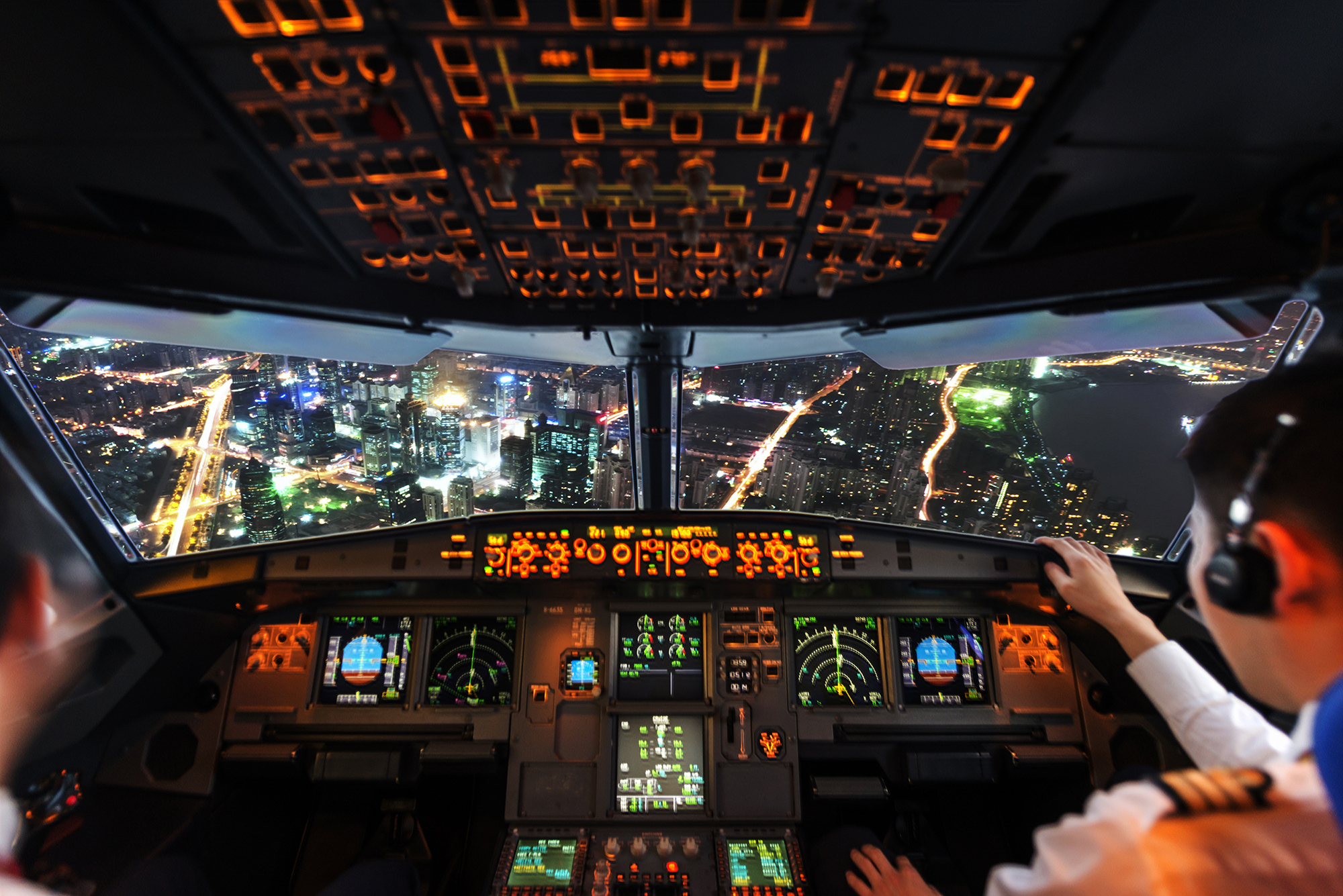
The first step to simply calculating your descent is determining where it should begin, known as the “Top of Descent” (TOD). It is important to note that the TOD is where your descent should begin, not where you should initiate the descent. Aircraft have inertia (thanks, Mr. Newton), and as a result, you will have to initiate the descent before your TOD, allowing the aircraft to begin descending at the TOD.
To determine your TOD:
- Determine your current altitude (or the initial altitude for your descent.) For our example, 10,000 feet.
- Subtract the altitude you want to arrive at once your descent is completed. If this is ground level, use elevation. For our example, 3,000 feet.
Therefore, in our example: 10,000 – 3,000 = 7,000.
- Multiply this number by three, and divide by 1,000. In other words, remove three zeros.
Therefore, in our example:
7,000 ÷ 1000 = 7
You will therefore begin your descent 21 nautical miles from your arrival point. Easy!
But how quickly will you descend?
To determine the required Rate of Descent (ROD) for a three-degree glideslope, simply multiply your groundspeed by 5.
For our example, we’ll use 80 knots.
Therefore: 80 x 5 = 400
An easier, pilot-friendly way to quickly make a multiplied by five calculation is to divide your groundspeed (or any number) by two and add a zero to the end of the number.
For example:
80 ÷ 2 = 40
40, add a zero to the end = 400.
If only nature wouldn’t mess with our mathematics…
Private Pilot Made Easy
Wind, by its very nature, is dynamic. Wind speed and direction vary with height, meaning as you descend, your groundspeed will change, bringing you either further or closer to your arrival point than you calculated, as your rate of descent (should have) remained constant.
Generally speaking, if your descent is shorter, for example, a few thousand feet, the change in wind speed and direction will not be significant enough to make a noticeable difference.
If your descent is more prolonged, for example, 10,000 feet, there is a good chance that the wind will be significantly different by the time you arrive at the arrival point.
Luckily, there are two ways of mitigating these potential errors:
As you descend, monitor your groundspeed, and adjust your Indicated Airspeed (IAS) accordingly while maintaining a constant Rate of Descent (ROD). Although possible, this is a very tedious exercise because you will have to constantly adjust airspeed and power settings during the descent, depending on how significant the change in wind speed or direction will be.
For example, you are descending from 16,000 feet to 3,000, and your groundspeed is 100 knots. Try to calculate the Top of Descent (TOD) and Rate of Descent (ROD) by yourself before looking at the example below.
16,000 – 3,000 = 13,000
13,000 ÷ 1,000 = 13
13 x 3 = 39
TOD = 39 nautical miles .
100 x 5 = 500 or (100 ÷ 2 = 50 add a zero = 500)
ROD = 500 feet per minute.
As you descend, you notice the tailwind has increased, causing your groundspeed to increase to 120 knots, so you have to recalculate.
Choose an altitude you will pass soon (but not too soon, you need to do the math first!). Let’s say you are passing 7,000 feet at 500 feet per minute, so you choose 6,500 feet, giving you one minute to make the calculations, which is more than enough time.
Now simply run the calculations using your new groundspeed and altitude.
You now determine that your new TOD for a three-degree glideslope is 10.5 nautical miles, and your rate of descent will be 600 feet per minute.

These rules are used more often than you think, even in larger aircraft. Aviation is a dynamic environment where it is sometimes more efficient to make a quick rule of thumb calculation than input data into a computer. Often, these rules are used to initiate a descent, allowing time to input data into the computer at a later stage.
But, although incredibly useful, these are only rules of thumb. As much as we try, the aircraft’s computers will always be better and faster at math than pilots. When practicable, use the onboard systems to make descent profile calculations.
In summary:
Top of Descent (TOD)
Current altitude 10,000 feet – final altitude/elevation 3,000 feet = 7,000 feet.
7,000 feet ÷ 1,000 = 7
TOD = 21 nautical miles from arrival point.
Rate of Descent (ROD)
Groundspeed x 5.
Groundspeed ÷ 2 and add a zero at the end.
Similar Articles

Surface Analysis Charts Explained
Airport Beacons Explained

What to Expect on Your First Introductory Discovery Flight

Scored % on their FAA Exam

The Lowdown On Descents
There’s a right way and a wrong way to bring your airplane down.
Descents are too often regarded as throwaway maneuvers. Pilots place great emphasis on proper techniques for takeoff, approach, landing and cruise, but few are educated in the best techniques for descent. If you're one of those pilots who loves to fly low and slow---or even low and fast---descent planning may not be much of a concern. Most of the time, Cub and Champ drivers need hardly worry about descents from 1,500 to 2,500 feet AGL.
For the rest of us, however, descents should be more meaningful. General-aviation airplanes that typically cruise in the bottom 25,000 feet of the sky can improve efficiency by narrowly controlling descents. In some instances, proper descent and approach can be a prelude to a successful landing.
Different airplanes descend in different ways. Military fighters are perhaps the most extreme. As I learned firsthand in 1979, a tactical descent in an F-15 Eagle may involve a roll to inverted followed by a pull-through to near-vertical down with the speed brake fully deployed, often at 35,000 fpm. (That's 350 knots straight down.) Fuel is critical in an F-15---full tanks are worth only about 1.5 hours---so transitions to and from high altitude are flown expeditiously.
Fuel-conscious airliners almost always descend at near-idle power, averaging 1,500 to 2,000 fpm in their profile letdowns and coasting downhill in the most efficient glide possible. A 747-100 burns about 3,400 gallons of Jet A per hour, and at today's prices, the sooner the crew can reduce power, the better. Heavily loaded Boeings, Lockheeds and Airbuses often boast glide ratios half of those for general-aviation models, on the order of 15:1 or even 20:1 for the big guys, and that means they're notably more efficient during power-off glides.
In contrast, descents in general-aviation aircraft can vary significantly, depending on conditions and model. In the summer, what looks like semiclear air below can be uncomfortably choppy, especially over uneven terrain. Similarly, it may be miserably hot in the lower layers of atmosphere. There's often a perpetual inversion overlying much of the country, especially in the vicinity of major cities. That means it could be the same temperature or hotter from ground level to 5,000 feet. For most of us who fly airplanes without air conditioning, that's a good reason to maintain big altitude as long as possible.
Conversely, if you're flying above an undercast and have reason to believe there might be ice lurking below, you might want to minimize your exposure by staying high as long as possible, dropping through the frozen glop at the last possible minute. This will demand coordination with ATC, but controllers in the Far North are usually fairly savvy to operational demands. I've used this technique on the North Atlantic dozens of times during all four seasons to avoid becoming a popsicle.
Pilots who like to fly their turbocharged models in the flight levels can expect a different attitude from ATC than if they were letting down from 10,000 feet. By definition, operation in the flight levels demands an IFR clearance, and for that reason, controllers are more demanding with pilots operating in the positive control environment. If you're cruising at FL240 and request a lower altitude, the controller is likely to expect a minimum of 1,000 to 1,500 fpm down, even if he or she approves descent at the "pilot's discretion."
Controllers don't differentiate between turbine and piston airplanes in the flight levels, and that means they sometimes may assume your airplane is pressurized and that high descent rates are no problem. You'll often hear controllers ask you to increase your descent rate, but you'll rarely be asked to slow your letdown. In 30 years of operating turbocharged, turboprop and pure jet aircraft in the flight levels, I've probably been asked to expedite my descent a hundred times, but I've rarely been asked to reduce the rate.
There's a noticeable difference in descent planning from the flight levels and letting down from a mile or three MSL. For one thing, winds are less of a factor down low, so you're likely to see a slight improvement in groundspeed at modest heights and exactly the opposite while descending from high altitude.
When operating at a comparatively low level and flying VFR in a typical 160-knot, single-engine retractable, calculating the vertical descent point can be a simple matter of dividing the altitude to be lost by your chosen descent rate, comparing that to your expected average descent airspeed and, assuming there's no topography in the way, starting down at the appropriate time. For example, if you're cruising at 9,500 feet and planning a 500 fpm descent to a pattern altitude of 2,000 feet, five miles from the airport, that's 7,500 feet to lose (15 minutes' worth at 500 fpm). If you realize a 20-knot cruise improvement (consistent with Vno limits, of course), you'll want to start down about 50 miles out.
In the VFR world, most general-aviation pilots like to be down to pattern altitude at least five miles before the airport, so it's necessary to add that to your distance calculation. This gives you time to stabilize and prepare for the approach, even if it's just a standard 45 entry to a downwind, base and final. Another benefit of getting low early is that it's far easier to spot traffic at the same altitude or even a little above you against a featureless blue sky than trying to pick it out of a mishmash of houses, freeways and shopping centers below.
As mentioned above, descents from the flight levels can often result in a slower groundspeed. If that seems contrary to common sense, remember that jets, turboprops and turbocharged piston airplanes are much more efficient in the thin air above 18,000 feet. Similarly, a fringe benefit of high-altitude flight can be tailwinds. For these reasons, pilots of turbine equipment prefer to fly high as long as possible. Controllers oblige with their own "keep 'em high" policy, typically assuming pilots will oblige with descent rates of at least 1,500 fpm.
When you're flying VFR at 17,500 feet or less, there are a couple of methods you can use to figure your descents. One is to simply choose a descent rate (500 fpm in the example above) and back in to the descent point.
Another is to assume a given ratio of altitude to forward distance. The airlines like to assume a 3:1 ratio---three miles of horizontal travel for every 1,000 feet of altitude loss. More than coincidentally, that's roughly a three-degree glide-slope and will dovetail nicely with a typical ILS approach.
While three degrees is a standard profile for the last 10 miles to the airport, it may be a little abrupt for unpressurized airplanes with piston engines, descending from greater distances. There's little question that shock-cooling can be a factor in premature engine failure, as different metals inside the engine expand and contract at different rates. The slower you cool the engine, the better.
A gentler 5:1 ratio seems to work better for VFR descents. All other considerations being equal (which happens about one flight in 100), if you have 9,000 feet to lose between cruising level and pattern altitude, you'll want to begin descent 50 nm out (45 plus 5), providing there's nothing to hit in between.
In a typical 120-knot, fixed-gear single, you require 22.5 minutes for an average descent rate of 400 fpm. If you're traveling at 180 knots, you'll start down at the same point, but you'll need to maintain a 600 fpm descent to arrive at the right altitude at the proper time. At the below-10,000-foot speed limit of 250 knots, you'll need to maintain about 1,350 fpm to make the planned altitude.
Deciding whether to descend at cruise power or with reduced throttle has always been a subject of some debate. If you're flying high enough, you could leave the left knob/lever full forward until the airplane reaches the max 75% power altitude, then begin reducing power gradually to avoid exceeding the limit as you descend. That could be the best way to go for engine cooling, but on some airplanes, it also might drive the airspeed up into the yellow---not a good idea.
You could alleviate the problem by reducing the descent rate and starting down farther out, or you could choose to reduce power slightly to maintain the same indicated airspeed throughout the descent. Unfortunately, the slight increase in airspeed you'll realize at higher power down low won't reduce your time en route by much, as it will only apply for a short distance.
If you need to go down and slow down at the same time, the best method is to use drag devices such as speed brakes---if you're lucky enough to have them---approach flaps or gear. (Definitely don't use cowl flaps. In fact, if the engine has been running warm enough to justify cowl flaps in trail, the descent might be a good time to close them.) Gear is the last choice because it often imposes unacceptable speed limits, whereas speed brakes and approach flaps are less aerodynamically constrained. Be aware, however, that approach flaps may reduce allowable load limits, so you might want to plan ahead if you're expecting rough air during the letdown.
Don't forget the mixture during a descent, probably the most common error pilots make coming downhill. You'll obviously need to push in the red knob to maintain the ideal 15:1 fuel air ratio. An EGT makes the process simpler, and an engine analyzer makes it easier still, but even without either option, experience should allow you to make a SWAG estimate of mixture positions for the lowering altitudes.
During any descent, it's especially important to clear the airspace ahead. Too often, pilots initiating descent focus on the narrow slice of sky straight ahead, ignoring possible threats from the side. The better policy is to check the airspace diligently, including the sky to both sides and below. Make occasional clearing S-turns left and right that allow you a view of the world below as well as ahead.
All that remains after a proper descent is a perfect landing, and anyone can do that. Right?

Subscribe to Our Newsletter
Get the latest Plane & Pilot Magazine stories delivered directly to your inbox
Subscribe to our newsletter

- CFI Tools
- All Articles
- Aerodynamics
- Performance
- All Quizzes
- Fun Quizzes
- VFR Quizzes
- IFR Quizzes
- Aleks Udris
- Colin Cutler
- Swayne Martin
- Swag & Wallpaper
- Tips, Stories & Pitches
- Demographics & Reader Statistics
- Media Options
- Weather Reports & Forecasts
- Turns Around A Point
- Forces In A Turn
- Forces In Climbs And Descents
- CG Effects On Performance
- Terms & Policies
- Terms of Service
- Privacy Policy
- Refund Policy
- Security Policy

Is It OK To Fly In The Yellow Arc?
- By Boldmethod
Has someone ever told you to avoid flying in the yellow arc? In many airplanes, it's not an easy task.
What Is Vno?
The FAA defines Vno in the Pilot's Handbook of Aeronautical Knowledge as "the maximum speed for normal operation or the maximum structural cruising speed . This is the speed at which exceeding the limit load factor may cause permanent deformation of the aircraft structure." The definition sounds a little clunky, right? As you'll read about below, "the maximum structural cruising speed" gets confused with Vne all the time, but that couldn't be farther from the truth.
When taking a look at the Vg diagram, you'll notice a line that designates maximum structural cruising speed. As you fly faster and faster, any change in angle of attack will result in a greater G load imposed upon the airplane. This could cause the aircraft to reach the upper or lower area of structural damage shown in the diagram below.
Manufacturers publish Vno to provide a safe buffer zone between normal airspeeds, and airspeeds that could cause a structural failure during high speed flight. During slow speeds, moderate turbulence will result in relatively small G-loading. As speed increases, the G forces associated with turbulence have a much stronger effect on aircraft load limitations. This is one reason you'll start to feel uneasy sooner, as you fly into turbulence at faster airspeeds. Your body is experiencing more G-loading, just like your airplane.
On your airspeed indicator , Vno is represented by the point at which the green arc ends and the yellow arc begins. The Vno speed for your plane is published in the POH.
In Some Airplanes, Flying In The Yellow Arc Is "Normal"
In an article on mooneypilots.com , a test pilot reports that...
"The top of the green arc/beginning of the yellow arc on the M20C is an impossibly low 130 KIAS. My gosh, in the C model you are almost cruising in the yellow arc in level flight! This is a significant limitation for descent if you are to abide by the airspeed markings."
If you're flying something like a Cessna 172, it's pretty hard to reach Vno, and impossible in level flight. According to the C172S POH, 129KIAS is the maximum structural cruising speed. The POH instructs pilots: "Do not exceed this speed except in smooth air, and then only with caution." If you've ever flown a C172, you know that to reach Vno, you have to fly a high descent rate, combined with a high power setting. There just aren't many cases where you'll find yourself in the yellow arc.
But in planes like the Mooney, Cirrus SR22, and other high-performance singles, you have to make a judgment about whether to descend using cruise power, or a reduced power setting. This is, in part, determined by how smooth the air is. Judging this "smoothness" isn't as easy as it sounds, and the FAA provides no definition for "smooth air."
Occasional small bumps are nothing to worry about. When you start noticing controllability problems or substantial airspeed changes, it's always smart to slow down below Vno. Smoother air is better for airframes when it comes to flying at fast airspeeds. Plus, you and your passengers will feel much more comfortable at slower speeds during turbulence.
What Should You Do?
Always reference your aircraft POH about Vno speeds, definitions, and procedures. Don't be afraid of flying in the yellow arc, but always be cautious about the air conditions around you. If you find yourself flying too fast, you can control your speed by reducing power or slowing your descent rate. Both of these options in combination are a great way to ensure you're flying at a safe speed.
Vno doesn't need to be treated as a Vne (never exceed) speed, because your airplane is certified to fly within that range under the right conditions. As long as you're cautious, you won't damage the aircraft. That said, repeated flights in the yellow arc in anything but smooth air will impose repeated stress on your airframe. Over time, this stress could lead to structural failure. Simply put, if the air isn't smooth, slow down below Vno.
What do you think? How often do you fly in the yellow arc?
Paying too much for aircraft insurance? Get your free quote from AssuredPartners today.
Become a better pilot. Subscribe to the Boldmethod email and get real-world flying tips and information direct to your inbox, every week.

- Arpingstone
- Lane Pearman
Recommended Stories

- Nicolas Shelton

Latest Stories

- [email protected]
- 720-663-7754
- [email protected]
- facebook.com/boldmethod
- About Boldmethod
- © 2024 Boldmethod, LLC
- Terms and Policies


Descending From Cruise Altitude
Featuring Bob Nardiello
Subscriber question:
"What is the best point to start a descent on a VFR cross-country flight? Or put otherwise, what is the best rate of descent (FPM) to fly a comfortable descent and enter the traffic pattern?" - Philip
“500 feet per minute is a good rate to work with. Generally, passengers will not be alarmed by a decent rate of 500 ft/min. Pressure changes will occur slowly in an unpressurized aircraft.
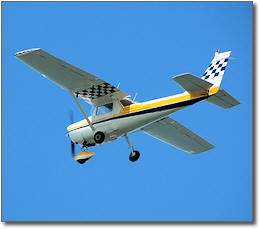
Let’s say traffic pattern is 1,000 feet AGL, and you need to lose 4,000 feet to get from your cruising altitude (5,000 ft) to pattern altitude. At 500 ft/min, it will take you 8 minutes to lose 4,000 feet. At 120 knots which is two miles per minute (120 nautical miles per hour divided by 60 minutes = 2 miles per minute), you need to begin your descent 16 miles out.
If you have a GPS with a VNAV function, it will do this calculation for you. Learning to use it is a worthwhile exercise and not difficult.
On the VNAV page you enter the destination, desired altitude that you will be descending to (AGL or MSL altitude), and distance from the airport where you want to be at this altitude. Typically if you are entering a traffic pattern at an airport, you probably want to be at that altitude 2 or 3 miles from the airport. You will then see on the screen the necessary descent rate to make that happen.”
You may find this video from the Air Safety Institute helpful:
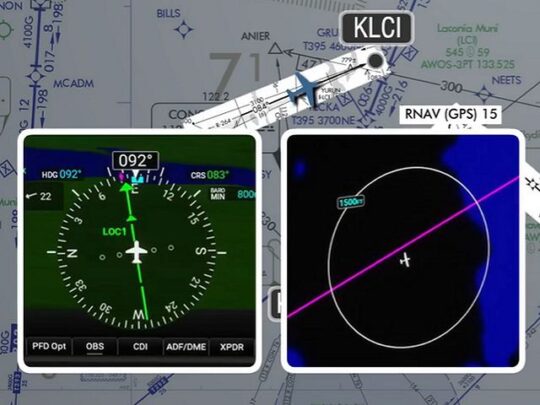
Get the Pilot’s Tip of the Week
Sign up here to receive tips like this every week along with videos, quizzes and more..
- Phone This field is for validation purposes and should be left unchanged.
You are here
Drift down procedure.

Drift Down is a maximum thrust/minimum rate descent necessitated by an engine failure in a multi-engine aircraft in the latter stages of climb or during cruise when an aircraft cannot maintain its current altitude and terrain clearance or other factors are critical.
Description
The optimum cruising altitude for an aircraft with all engines operating normally is primarily dependent upon aircraft mass and the temperature deviation from ISA . In almost all cases, an aircraft’s optimum cruising altitude will exceed the One Engine Inoperative (OEI) service ceiling. An engine failure occurring above OEI service ceiling will therefore necessitate a descent and in most cases a Drift Down procedure will be followed.
The Drift Down procedure entails setting maximum continuous power/thrust on the operating engine(s) whilst countering any adverse yaw with rudder, and then trimming and disconnecting the autothrottle(AP)/autothrust(AT) system where applicable.
(Note that on some aircraft disconnecting AT may not be required and may actually make the desired profile more difficult to achieve; as always, it is important to know, understand and carry out the manufacturers/ operators approved procedures.)
The appropriate drills and/or checklists for the failure are completed when time and capacity allow. At the appropriate speed, a descent to the Drift Down altitude is initiated while maintaining maximum continuous power/thrust.
By definition, the OEI Service Ceiling is:
- the altitude to which, following the failure of an engine above the one engine inoperative service ceiling, an aeroplane will descend to and maintain, while using maximum available power/thrust on the operating engine and maintaining the planned OEI speed.
Several possible speed strategies are associated with drift down. These include fixed speed and obstacle clearance strategies.
- Obstacle clearance strategy allows the aircraft to maintain cruising altitude the longest, provides the least possible rate of descent and will result in the highest possible engine out cruising altitude for the conditions. In this procedure, maximum continuous thrust is set and (except in aircraft where AP & AT will maintain the required level of thrust and descent profile) the autothrottle disconnected. The speed target is adjusted to the best engine out speed and altitude is maintained while the speed slowly decays from the all engine cruising speed. When the target speed is achieved, a descent at maximum continuous power/thrust and the target airspeed is initiated. During the descent, speed is adjusted to maintain the best speed for the current altitude and the descent is continued until Drift Down altitude is reached. Cruise will then continue at best speed and maximum continuous thrust and, if required, the aircraft will climb as it becomes lighter. If obstacle clearance is not a factor, the descent can be continued and the power/thrust decreased or speed increased as appropriate.
- Fixed speed strategy involves the same immediate actions of maximum continuous power/thrust, yaw compensation and disengagement of autothrottle (where appropriate) but the descent is started sooner while at a higher speed, maintaining this speed during the drift down profile. By definition, a higher speed will result in a lower engine inoperative cruising altitude. This strategy may be used to meet ETOPS criteria on certain routes. If so, this should be clearly annotated by the Operator in either their SOPs and/or the flight plan given to the pilots.
Handling Considerations
After an engine failure or shutdown the principal handling requirement is to counteract any thrust asymmetry using rudder and trim as required to maintain the aircraft in balance. In some aircraft this will enable the auto-flight system to remain engaged and maintain control of the aircraft without reaching the limits of its control authority.
The other priority is to ensure that Max Continuous thrust is applied, either by the AT system or manually. In some aircraft the auto-flight & Auto Thrust system will manage this very well if the correct selections are made on the FMC.
Once those two things have been achieved, things generally happen quite slowly enabling some time to be given to consideration of the required descent profile and FMS/ FMGS selections to be made. Pilots can refer to their operations manuals where Drift Down performance is tabulated; by comparing aircraft weight at the time of engine failure with temperature deviation from ISA, the crew can obtain their OEI service ceiling and speed regime. They can also determine time, distance and fuel burn from cruise altitude to their MEA / MORA /safe altitude.
Operational Considerations
If at the time of engine failure, the aircraft is above the OEI service ceiling, a descent will be required. Prevailing circumstances such as terrain, ATC requirements or if following an organised track system will dictate whether that descent needs to be
a) the shallowest possible profile (drift down),
b) delayed or
c) can be carried out using normal economy speeds.
Liaison with ATC will be required. It may be necessary to declare an emergency to ensure that ATC permit the required flight profile.
1) Maximum Performance (shallowest profile for terrain avoidance) Required
This will need accurate handling of the auto-flight system. To achieve best performance, it is important that the aircraft manufacturer’s/ operator’s procedures are well understood and carefully followed. In particular the indications of and required selections on any FMS / FMGS fitted to the aircraft need to be well understood to make the aircraft follow the best Engine Out Speed with Max Continuous Power set.
2) Delayed Descent Required
If the descent needs to be delayed due to traffic, ATC or organised track turn back requirements, once Maximum Continuous Power is applied descent can be delayed by allowing the speed to reduce below command speed, but no lower than the flaps up manoeuvring speed, before commencing descent. Once again a clear understanding of how to make the required selections on the FMS/ FMGS will be needed. ATC procedures and collision avoidance may dictate the direction of initial descent, particularly on oceanic tracks and when communication is either degraded (HF only) or not available. In this situation, fuel and time factors may require that a faster descent is made to below the restriction so that the aircraft can be turned towards the alternate airfield.
3) Terrain or delayed descent not a factor
In this case maximum performance is not needed and the aircraft can be flown using OEI and normal company speeds/ normal VNAV descent as required.
Icing & Aircraft Performance Considerations
Only engine icing is considered in fuel planning, but airframe icing will adversely affect aircraft performance aerodynamically and by adding weight. Moreover, with one engine out, wing de-icing could be asymmetric. If the OEI descent involves either descent through an icing layer or stabilisation within the layer, the Commander should consider increasing descent speed to minimise the time spent within the layer and, if necessary, establishing a lower single engine cruise altitude that is below the icing layer. Where the icing layer extends below Minimum Safe Altitude (MSA), this should have been considered before the flight at the planning stage. The availability of oxygen escape routes may be helpful for such decision-making.
Smaller twin-engined aircraft with less excess power and operating at lower altitudes are likely to need to consider MSA, icing and escape routes on a more regular basis.
NOTE: In this context MSA is used generically and the Operator may provide guidance on the use of Grid MORA and minimum altitudes on an escape chart.
As well as icing, other factors can prevent an aircraft from meeting the performance published in the manuals and aircraft age, servicing and an incorrect ZFW may contribute to a lower drift down altitude and single pressurisation pack performance may not be able to maintain the required cabin altitude. These factors could also influence the outcome of the crew’s decision-making process.
Related Articles
- Engine Failure: Guidance for Controllers
- Uncontained Engine Failure
- Fuel - In-Flight Management (Abnormal Operations)
- Mountainous Terrain Escape Routes
SKYbrary Partners:

Safety knowledge contributed by:
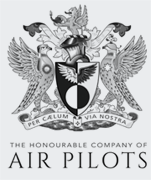
Join SKYbrary
If you wish to contribute or participate in the discussions about articles you are invited to join SKYbrary as a registered user
Message to the Editor
About SKYbrary
What is SKYbrary
Copyright © SKYbrary Aviation Safety, 2021-2024. All rights reserved.
672 Wine Club
- Motorcycles
- Car of the Month
- Destinations
- Men’s Fashion
- Watch Collector
- Art & Collectibles
- Vacation Homes
- Celebrity Homes
- New Construction
- Home Design
- Electronics
- Fine Dining
- Benchmark Wines
- Brian Fox Art
- Chase United
- Disneyland Resort
- Sports & Leisure
- Health & Wellness
- Best of the Best
- The Ultimate Gift Guide
From Underwater Jetpacks to Personal Subs: 13 Ways to Stay Entertained on Your Yacht Cruise
Days at sea need never drag on with these game-changing distractions., j. george gorant, j. george gorant's most recent stories.
- Electric Air Taxis Are Poised to Help L.A. Transport Fans During the 2028 Olympics
- Paris Airports Have Undergone Major Overhauls Ahead of the Olympics
- The Space Tourism Race Is Heating Up—Here’s Everything You Need to Know
- Share This Article

The definition of “yacht toy” has expanded far beyond Jet Skis and Seabobs. These days, it can include electronic items such as sophisticated drones for recording voyages or portable 4G projectors that can turn any wall into an instant cinema. There are also big expensive toys like personal submersibles, or small, featherweight gear like the latest GoPro camera. In between: a tech golf machine that sits on the rear of the boat, making recommendations for your swing, a backpack jetpack that lets you swim like a barracuda, or a compressor that floats on the surface, making scuba tanks unnecessary. Here are the latest, coolest toys that will launch your vessel into a new realm of fun and adventure.
Cudajet Underwater Jetpack

This sleek electric jetpack delivers effortless, dolphin-like diving, spinning, and cavorting at nine feet per second. Rated to 131 feet for professional free divers, the controller and floating safety harness limit descents to 10 feet for everyone else. $18,000
U-Boat Worx Super Yacht Sub 3

Thanks to powerful thrusters, U-Boat Worx ’s three-passenger Super Yacht Sub 3 can dive to 1,000 feet. Inside the acrylic dome are plush seats, air-conditioning, a Bluetooth audio system, and 360-degree views of your aquatic playground. $3.35 million
Acqua Springboard

These custom-built tapered carbon-fiber diving boards feature the same type of inlaid mahogany as elegant Riva boats of the 1960s—and add the same dolce vita flair to any on-deck pool. The designers make two versions, this pictured Gracie Bird but also a new Rio with the same quality but a different look. From $25,000
Bugatti Pool Table

The handcrafted skin and carbon-fiber shell above the aeronautical-grade aluminum frame of this billiard table evoke Bugatti’s high-performance automotive design while the optional gyroscope and quiet servo motors maintain a level surface no matter how rough the conditions. About $315,000
Lotus Type 136

Fit with a motor developed for the Mars Rover, this e-bike turns every port of call into your training ground with its carbon-monocoque design, three hours of pedal boost, and battery disguised as a water bottle. About $27,000
Candela C-8 Polestar

This future-forward limited-edition cruiser embraces the latest advances in marine design with its all-electric propulsion and gold-colored foils that raise its 28-foot hull three feet above the water—a statement tender in all seas. $450,000
Mavic 3 Pro

This drone’s 40-minute flight time and ability to detect and avoid obstacles are impressive, but its standout features are the Hasselblad camera for still shots plus dual video units—with different depths of field—to precisely document voyages from multiple views. $2,200
Off the Deck SeaDriveCX

The SeaDriveCX introduces a high-tech approach to onboard golf, capable of bringing real-time analytics and data to your swing while providing virtual rounds at Pebble Beach or St. Andrews. The balls, naturally, are biodegradable. Price upon request
Superyacht Inflatable Wave Lounger

The Fun Air Superyacht Inflatable Wave Lounger brings a combo of comfort and versatility to the swim platform of any vessel. It looks good on deck—especially with custom covers that can match your boat name and colors—floats alongside the yacht and folds up into a small pack (31.5” x 20” x8”) that’s easy to store or tote to the beach for an afternoon ashore. Price upon request
Seabob F5 SR

The Seabob F5 SR is the most powerful of Cayago’s surface scooter/underwater sleds. It comes with built-in HD cameras, a powerful thruster (top speed of 13.5 mph along the water’s surface and 12.5 mph underseas), wi-fi connectivity and a spectrum of bright color options. About $16,550
LG CineBeam Q

The LG CineBeam Q is a portable 4K projector that sets up just about anywhere. An auto screen function adapts to the available projection space and instantly focuses, eliminating much of the hassle, and when hooked up to the internet, the device can connect directly to streaming services. $999.99
GoPro Hero12 Black + Max

GoPro has been at the action-cam game for a while now, but its new Hero12 Black + Max still packs in a bunch of new features, including 5.3K and 4K video modes, advanced image stabilization and 177° field of view. And, of course, it’s waterproof to 33 feet. $429.99
Supmaran Light

The Supmaran Light is a small boat fashioned out of two stand-up paddle boards, a frame and a waterproof storage compartment. The entire package weighs about 85 pounds, folds up into three easy-to-stow containers and snaps together in about 15 minutes. Add a small electric motor if you prefer puttering over paddling. $2,100
Read More On:
More marine.

This Speedy New 700 HP RIB Can Soar to 55 Knots at Full Tilt

Kevin Costner Cruised on This Luxe 75-Footer Last Summer. Now It’s Debuting at Cannes Yacht Fest.

This New 161-Foot Explorer Yacht Offers 6 Days of Autonomy at Sea

Luxury Riverboats Are Giving Superyacht Charters a Run for Your Money

Meet the Wine Club That Thinks Differently.
Receive editor-curated reds from boutique California producers four times a year.
Give the Gift of Luxury
Latest Galleries in Marine

9 Fascinating Facts About ‘Koru,’ Jeff Bezos’s Bonkers 410-Foot Sailing Superyacht
More from our brands, celebrities front row at tommy hilfiger spring 2025: jisoo, patrick schwarzenegger, brooke shields, colin jost and more, ncaa could roll dice on winning house case at scotus, italy’s film industry hopes resignation of scandal-plagued culture minister will help remove legislative obstacles choking production, slovakian culture workers launch strike against government’s ‘ideologically motivated censorship’, the best yoga mats for any practice, according to instructors.

IMAGES
VIDEO
COMMENTS
Cruise Clearance = Cleared For The Approach. When given a cruise clearance, you're automatically given a clearance to execute an instrument approach at your destination airport. You don't have to request an approach and you won't hear the words "cleared for the approach." Descent planning, all the way down from en-route altitude, is all up to you.
Cruise descents result in an incremental gain. Saving 5 to 10 minutes per flight might seem insignificant and could easily be wiped out by a bad vector in the terminal area. However, shaving off that kind of time on average over the course of just a handful of flights, could easily save a half hour or more.
During cruise and descent, these forces play pivotal roles in determining speed, altitude, and direction. 2. Aerodynamics of Cruising: Cruising is the phase where an aircraft maintains stable flight at a designated altitude. For commercial airlines, this is typically at high altitudes, usually above 30,000 feet. 2.1.
Cruise (aeronautics)
They will then climb at a maximum speed of 250kts/290mph while under 10,000 feet and then can speed up to 280-300kts/320-345mph for the rest of the climb. Cruise speeds of most passenger jets are around 600kts/700mph. To find out all about the different speeds an airplane flies at please read on….
Practise the climb and descent as required, so that the student is comfortable with the entry, maintenance, and exit, and coordinates rudder with power changes. On the way back to the aerodrome, demonstrate the cruise descent, including the selection of power and rate of descent appropriate for the conditions.
Planning the descent from cruise is important because of the need to dissipate altitude and airspeed in order to arrive at the approached destination. Descending early results in more flight at low altitudes with increased fuel consumption and starting down late results in problems controlling both airspeed and descent rates on the approach.
Cruise descent: used to maximize. speed en route and when requested. by ATC (Fam flights will utilize. 250 KIAS) (1) If entry airspeed is 250 KIAS, reduce power as necessary to. maintain 1,500 to 2,000 fpm rate. of descent or as directed. (2) If entry airspeed is other than.
How to Calculate Top Of Descent
Descent: IFR: Descent from cruise to either Initial Approach Fix (IAF) or VFR pattern entry. VFR: Descent from cruise to the VFR pattern entry or 1,000 feet above the runway elevation, whichever comes first. Holding: Execution of a predetermined maneuver (usually an oval racetrack pattern) which keeps the aircraft within a specified airspace ...
How to Calculate Your Descent Profile (Airplane Pilots)
The Lowdown On DescentsDescents are too often regarded as throwaway maneuvers. Pilots place great emphasis on proper techniques for takeoff, approach, landing and cruise, but few are educated in the best techniques for descent. If you're one of those pilots who loves to fly low and slow' or even low and fast' descent planning may not be much of a concern. Most of the time, Cub and Champ ...
• Change of Cruise Level: Any climb or descent during cruise after the initial climb to cruise, but before descent to the destination. • Descent: IFR: Descent from cruise to either Initial Approach Fix (IAF) or VFR pattern entry. VFR: Descent from cruise to the VFR pattern entry or 1,000 feet above the runway elevation, whichever comes first.
But in planes like the Mooney, Cirrus SR22, and other high-performance singles, you have to make a judgment about whether to descend using cruise power, or a reduced power setting. This is, in part, determined by how smooth the air is. Judging this "smoothness" isn't as easy as it sounds, and the FAA provides no definition for "smooth air."
Normal descent. (Normal descent) 10404 Normal descent: IFR: Descent from cruise to either Initial Approach Fix (IAF) or VFR pattern entry. VFR: Descent from cruise to the VFR pattern entry or 1000 feet above the runway elevation, whichever comes first. Note: this slightly differs from the previous definition where 1,500 feet (450 metres) above ...
Unlike commercial operations that have well-defined phases of flight such as taxi, takeoff, climb, cruise, descent, approach, and landing, GA missions have more hard-to-identify phases of flight ...
During descent the throttle remains fully open, and the mixture is slightly (and occasionally) enriched (tweaked) just enough to maintain engine smoothness. The throttle is reduced and the mixture enriched ROP (readying the plane for possible go-around climb) when leveling out and slowing down for gear extension and landing.
At 500 ft/min, it will take you 8 minutes to lose 4,000 feet. At 120 knots which is two miles per minute (120 nautical miles per hour divided by 60 minutes = 2 miles per minute), you need to begin your descent 16 miles out. If you have a GPS with a VNAV function, it will do this calculation for you. Learning to use it is a worthwhile exercise ...
Descent (aeronautics) In aeronautics, a descent is any time period during air travel where an aircraft decreases altitude, and is the opposite of an ascent or climb. Descents are part of normal procedures, but also occur during emergencies, such as rapid or explosive decompression, forcing an emergency descent to below 3,000 m (10,000 ft) and ...
Definition. Drift Down is a maximum thrust/minimum rate descent necessitated by an engine failure in a multi-engine aircraft in the latter stages of climb or during cruise when an aircraft cannot maintain its current altitude and terrain clearance or other factors are critical. Description
Study with Quizlet and memorize flashcards containing terms like Airspeed limits for hands-off in VMC: Maneuvering, approach ____ Climb, cruise, descent. _____ Definition of attentive: Ready to _____ when the aircraft departs the expected flight path., Minimum height for hands-off and feet-off operation during T/O and approach: _____ Minimum height for hands-off and feet-off operation in cases ...
Learn the definition of 'cruise descent'. Check out the pronunciation, synonyms and grammar. Browse the use examples 'cruise descent' in the great English corpus. ... initial cruise, descent, approach and landing. EurLex-2. In the case of long haul operations where additional operating flight crew are carried, ...
The definition of "yacht toy" has expanded far beyond Jet Skis and Seabobs. These days, it can include electronic items such as sophisticated drones for recording voyages or portable 4G ...